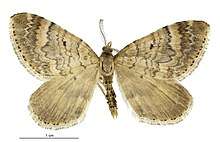Asaphodes dionysias
Asaphodes dionysias is a species of moth in the family Geometridae. This species is endemic to New Zealand. The female of the species has reduced wing size in comparison to the male. It is only known from mountainous areas in Central Otago.
| Asaphodes dionysias | |
|---|---|
 | |
| Male | |
| Scientific classification | |
| Kingdom: | Animalia |
| Phylum: | Arthropoda |
| Class: | Insecta |
| Order: | Lepidoptera |
| Family: | Geometridae |
| Genus: | Asaphodes |
| Species: | A. dionysias |
| Binomial name | |
| Asaphodes dionysias | |
| Synonyms[2] | |
| |
Taxonomy
This species was described by Edward Meyrick in 1907 as Xanthorhoe dionysias using material collected by J.H. Lewis at the Old Man Range in Central Otago in February.[2][3] George Hudson discussed and illustrated this species under the name Xanthorhoe dionysias in his 1928 publication The Butterflies and Moths of New Zealand.[4]
In 1987 Robin C. Craw proposed assigning this species to the genus Asaphodes.[5] In 1988 John S. Dugdale agreed with this proposal.[2] The holotype specimen is held at the Natural History Museum, London.[2]
Description
Meyrick described the species as follows:
♂︎. 28 mm. Head, palpi, and thorax pale-ochreous tinged with brown-reddish. Forewings somewhat elongate-triangular, costa gently arched, subsinuate in middle, termen rather bowed, oblique, not waved ; pale greyish-ochreous, towards costa suffusedly tinged with reddish- ochreous ; basal area indistinctly striated with dark fuscous irroration ; median band defined anteriorly by two curved similar striae, posteriorly by three curved dark striae enclosing two lines, first pale, second slightly tinged with reddish- ochreous ; within median band are two suffused strife connected by a transverse dark-fuscous discal dot, first obsolete in middle ; terminal area irrorated with dark-fuscous ; an interrupted dark-fuscous terminal line : cilia pale-greyish-ochreous, barred with dark-fuscous irroration. Hindwings elongate, termen rounded, faintly waved ; pale greyish-ochreous, thinly irrorated with grey ; a blackish discal dot ; a cloudy grey postmedian line ; cilia pale greyish-ochreous mixed with grey.[3]
The female of the species is brachypterous.[6]
Distribution
This species is endemic to New Zealand.[1][7] This moth is known only from a limited area which includes The Remarkables, Ben Lomond, Dunstan Mountains, and Old Man Range in Central Otago.[8]
Habitat and host species
This moth prefers open grassy mountainous habitat at altitudes of up to 1750m.[4][8] It is known to frequent wetland habitat.[8][9] Larvae of this species feed on herbs found in the wet tussock grassland.[6]
References
| Wikimedia Commons has media related to Asaphodes dionysias. |
- "Asaphodes dionysias (Meyrick, 1907)". www.nzor.org.nz. Landcare Research New Zealand Ltd. Retrieved 21 August 2018.
- Dugdale, J. S. (1988). "Lepidoptera - annotated catalogue, and keys to family-group taxa" (PDF). Fauna of New Zealand. 14: 173. Retrieved 21 August 2018.
- Meyrick, Edward (1907). "Notes and descriptioins of Lepidoptera". Transactions and Proceedings of the New Zealand Institute. 39: 106–121 – via Biodiversity Heritage Library.
- Hudson, G. V. (1928). The Butterflies and Moths of New Zealand. Wellington: Ferguson & Osborn Ltd. p. 120. OCLC 25449322.
- Craw, R. C. (2 February 2012). "Revision of the genus Helastia sensu stricto with description of a new genus (Lepidoptera: Geometridae: Larentiinae)". New Zealand Journal of Zoology. 14 (2): 269–293. doi:10.1080/03014223.1987.10422997.
- Barratt, B. I. P.; Patrick, B. H. (1987). "Insects of snow tussock grassland on the East Otago Plateau". New Zealand Entomologist. 10 (1): 69–98. doi:10.1080/00779962.1987.9722513. ISSN 0077-9962.
- Gordon, Dennis P., ed. (2010). New Zealand Inventory of Biodiversity, Volume Two, Kingdom Animalia: Chaetognatha, Ecdysozoa, Ichnofossils. Vol. 2. Christchurch, N.Z.: Canterbury University Press. p. 459. ISBN 9781877257933. OCLC 973607714.
- Patrick, Brian H.; Lyford, Brian M.; Ward, John B.; Barratt, Barbara I.P. (1992). "Lepidoptera and other insects of the Rastus Burn Basin, The Remarkables, Otago". Journal of the Royal Society of New Zealand. 22 (4): 265–278. doi:10.1080/03036758.1992.10420820. ISSN 0303-6758.
- Patrick, Brian H. (2014). "Ecology and conservation of the rare moth Asaphodes frivola Meyrick". The Weta. 47: 17–38.